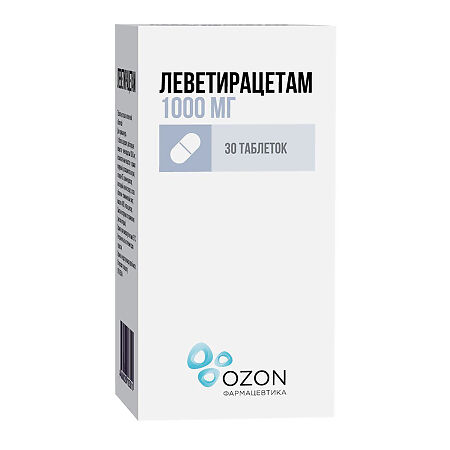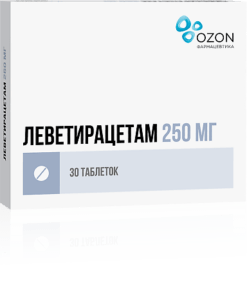No products in the cart.
Levetiracetam, 1000 mg 30 pcs
€1.00
Out of stock
(E-mail when Stock is available)
Description
As monotherapy in the treatment of:
- partial seizures with or without secondary generalization in adults and adolescents over 16 years of age with newly diagnosed epilepsy.
As part of complex therapy in the treatment of:
- partial seizures with or without secondary generalization in adults and children over 4 years of age with epilepsy;
- myoclonic seizures in adults and adolescents over 12 years of age with juvenile myoclonic epilepsy;
- primary generalized tonic-clonic seizures in adults and adolescents over 12 years of age with idiopathic generalized epilepsy.
.
Indications
Indications
As monotherapy in the treatment of:
partial seizures with or without secondary generalization in adults and adolescents over 16 years of age with newly diagnosed epilepsy.
As part of complex therapy for the treatment of:
partial seizures with or without secondary generalization in adults and children over 4 years of age with epilepsy;
myoclonic seizures in adults and adolescents over 12 years of age with juvenile myoclonic epilepsy;
primary generalized convulsive tonic-clonic seizures in adults and adolescents over 12 years of age with idiopathic generalized epilepsy.
Pharmacological effect
Pharmacological effect
Pharmacotherapeutic group: Antiepileptic drug
Special instructions
Special instructions
Cancellation of therapy
It is recommended to discontinue the drug gradually. For example, in adults and adolescents weighing more than 50 kg: the dose should be reduced in increments of 500 mg 2 times a day no more than every 2-4 weeks; in children over 6 years of age weighing less than 50 kg: dose reduction should be carried out in increments of no more than 10 mg/kg 2 times a day no more than every 2 weeks.
Kidney failure
The use of levetiracetam in patients with renal failure may require dose adjustment. In patients with severe hepatic impairment, it is recommended to evaluate renal function before starting dose selection (see “Dosage and Administration”)
Suicide
Suicidal thoughts and behavior have been reported in patients taking anticonvulsants (including levetiracetam).
A meta-analysis of randomized placebo-controlled trials of anticonvulsants showed a small increase in the risk of suicidal ideation and behavior. The mechanism for its implementation is unknown.
Because of the above, patients with symptoms of depression or suicidal thoughts and/or behavior should be monitored and treated accordingly. Patients (and their caregivers) should be advised to seek medical attention if they experience symptoms of depression and/or suicidal thoughts and behavior.
Children
The dosage form of the tablet has age restrictions for use in childhood (see “Indications”). According to available data, levetiracetam does not affect growth and puberty. However, the long-term effects on learning, intelligence, growth, endocrine function, puberty, and child fertility are unknown.
It is advisable to gradually discontinue concomitant antiepileptic drugs (during the period of transfer of patients to levetiracetam).
Impact on the ability to drive vehicles. Wed and fur.:
Studies on the effect on the ability to drive vehicles and operate machinery have not been conducted. Due to individual differences in susceptibility, some patients may experience drowsiness and other central nervous system disturbances, especially at the beginning of therapy and after dose increases. Therefore, it is recommended to be careful when driving vehicles and engaging in other activities that require increased concentration and speed of psychomotor reactions. If these symptoms occur, patients should avoid such activities until they are sure that these symptoms do not have a significant effect on them.
Active ingredient
Active ingredient
Levetiracetam
Composition
Composition
For one film-coated tablet:
Active ingredient:
Levetiracetam – 1000.00 mg,
Excipients:
Corn starch – 208.0 mg,
Povidone K30 (kollidon 30) – 52.0 mg,
Talc – 19.2 mg,
Colloidal silicon dioxide – 13.0 mg,
Magnesium stearate – 7.8 mg
Film casing:
Opadry II (white) [polyvinyl alcohol – 46.9%, macrogol 4000 – 23.6%, talc – 17.4%, titanium dioxide – 12.1%] – 30.0 mg.
Pregnancy
Pregnancy
Post-marketing data from several prospective pregnancy registries documented more than 1000 cases of levetiracetam monotherapy being prescribed in the first trimester of pregnancy.
Overall, these data do not indicate a significant increase in the risk of major congenital malformations, although teratogenic risk cannot be completely excluded. Therapy with multiple antiepileptic drugs is associated with a higher risk of congenital malformations than monotherapy, making monotherapy more appropriate in pregnant women. Adequate and strictly controlled clinical studies on the safety of levetiracetam in pregnant women have not been conducted, therefore the drug should not be prescribed during pregnancy or in fertile women who do not use reliable methods of contraception unless absolutely necessary.
Physiological changes in a woman’s body during pregnancy can affect the plasma concentrations of levetiracetam as well as other antiepileptic drugs. During pregnancy, a decrease in plasma concentrations of levetiracetam was observed. Treatment of pregnant women with levetiracetam should be carried out under special supervision. Interruptions in antiepileptic therapy can lead to a worsening of the disease, which can harm the health of both the mother and the fetus.
Levetiracetam is excreted in breast milk, so breastfeeding during treatment with the drug is not recommended.
Contraindications
Contraindications
– Hypersensitivity to levetiracetam or other pyrrolidone derivatives, as well as to any components of the drug;
– children under 4 years of age (safety and effectiveness have not been established).
With caution:
– Elderly patients (over 65 years old);
– liver diseases in the stage of decompensation;
– renal failure.
Side Effects
Side Effects
Based on clinical trial data and post-marketing experience with levetiracetam, the most common adverse reactions were nasopharyngitis, drowsiness, headache, fatigue and dizziness. The safety profile of levetiracetam is generally similar across age groups in adults and children.
Frequency of side effects: very common (≥1/10) common (≥1/100 to <1/10) uncommon (≥1/1000 to <1/100) rare (≥1/10000 to <1/1000) very rare (<1/10000) frequency not established (currently there are no data on the prevalence of adverse reactions).
From the blood and lymphatic system
Uncommon: thrombocytopenia, leukopenia.
Rarely: agranulocytosis, pancytopenia (in some cases with suppression of bone marrow function), neutropenia.
From the immune system
Rare: drug reaction with eosinophilia and systemic manifestations (DRESS syndrome).
Metabolism
Common: anorexia.
Uncommon: weight gain, weight loss.
Rarely: hyponatremia.
From the mental side
Common: depression mood changes hostility aggressiveness insomnia nervousness irritability anxiety.
Uncommon: confusion agitation hallucinations emotional instability psychotic disorders suicide attempts and suicidal thoughts behavioral disorders anger panic attacks mood swings.
Rare: completed suicide, personality disorder, thought disorder.
From the nervous system
Very common: drowsiness, headache.
Common: convulsions dizziness tremor imbalance lethargy.
Uncommon: paresthesia, amnesia, incoordination/ataxia, memory impairment, decreased concentration.
Rarely: hyperkinesia choreoathetosis dyskinesia.
From the side of the organ of vision
Uncommon: diplopia, accommodation disturbance.
From the side of the hearing organ
Common: vertigo.
From the respiratory system
Often: cough.
From the digestive system
Common: abdominal pain, diarrhea, dyspepsia, nausea, vomiting.
Uncommon: pancreatitis changes in liver function tests.
Rarely: liver failure, hepatitis, weight loss.
From the skin
Common: skin rash.
Uncommon: eczema, itching, alopecia (in some cases, hair restoration was observed after discontinuation of the drug).
Rare: toxic epidermal necrolysis, Stevens-Johnson syndrome, erythema multiforme.
From the musculoskeletal system
Uncommon: muscle weakness, myalgia.
Infections and infestations
Very common: nasopharyngitis.
Rarely: infections.
General disorders
Uncommon: asthenia, fatigue, accidental injury.
The risk of anorexia is higher when levetiracetam is used concomitantly with topiramate.
In placebo-controlled studies, the safety profile of levetiracetam in children (patients aged 4-16 years) was comparable to that in adults, with the exception of behavioral and psychiatric adverse reactions, which occurred more frequently in children than in adults. In children and adolescents aged 4-16 years, such undesirable reactions as vomiting (very often – 112%), agitation (often – 34%), mood changes (often – 21%), emotional lability (often – 17%), aggression (often – 82%), behavioral disturbances (often – 56%) and lethargy (often – 39%) were observed more often than in other age ranges.
Evaluation of the cognitive and neuropsychological effects of levetiracetam in children 4-16 years old with partial seizures (based on double-blind, placebo-controlled safety profile studies) showed that levetiracetam is no different (no less safe) from placebo in changes from baseline values on the Leiter-R Attention and Memory scale and the Memory Screen scale. Composite). The results of a study of behavioral and emotional functions confirming that aggressive behavior occurs during the use of levetiracetam were obtained using a standardized method using a validated instrument – the Achenbach Child Behavior Checklist. However, in patients taking levetiracetam long-term in open-label studies, disturbances in behavioral and emotional functions did not occur; in particular, the level of aggressive behavior did not differ from baseline.
If any of the side effects indicated in the instructions get worse or you notice any other side effects not listed in the instructions, tell your doctor.
Interaction
Interaction
Anticonvulsants
According to pre-registration clinical studies, levetiracetam does not affect the serum concentrations of other anticonvulsants: phenytoin carbamazepine valproic acid phenobarbital lamotrigine gabapentin topiramate and primidone, and these anticonvulsants do not affect the pharmacokinetics of levetiracetam.
Similarly to adults, in children in doses up to 60 mg/kg/day, levetiracetam does not interact with other drugs. A retrospective evaluation of pharmacokinetic interactions in children and adolescents with epilepsy (4-16 years) confirms that levetiracetam as an adjuvant therapy does not affect the serum Css of concomitantly administered carbamazepine and valproic acid. However, there is evidence that the clearance of levetiracetam in children taking anticonvulsants – inducers of microsomal liver enzymes – increases by 20%. No dose adjustment is required.
Probenecid
Probenecid (500 mg 4 times a day) is a blocker of tubular secretion at night and has been shown to inhibit the renal clearance of the main metabolite, but not levetiracetam. However, the concentration of the main metabolite remains low. It is expected that other drugs excreted by active tubular secretion may reduce the renal clearance of the main metabolite. The effect of levetiracetam on probenecid has not been studied; The effect of levetiracetam on other drugs excreted by active tubular secretion, including the non-steroidal anti-inflammatory drugs sulfonamide and methotrexate, is unknown.
Oral contraceptives and other pharmacokinetic interactions
Levetiracetam at a dose of 1000 mg/day does not affect the pharmacokinetics of oral contraceptives (ethinyl estradiol and levonorgestrel); hormonal status (the content of luteinizing hormone and progesterone) does not change. Levetiracetam at a dose of 2000 mg/day had no effect on the pharmacokinetics of digoxin and warfarin. The simultaneous use of digoxin oral contraceptives and warfarin does not affect the pharmacokinetics of levetiracetam.
Antacids
There are no data on the effect of antacids on the absorption of levetiracetam.
Food and alcohol
Food does not affect the extent of absorption of levetiracetam but slightly reduces its rate. There are no data on the interaction of levetiracetam with ethanol. There are isolated reports of a decrease in the effectiveness of levetiracetam when topical juice is used with osmotic laxatives, and therefore it is not recommended to take osmotic laxatives simultaneously within one hour before and within one hour after taking levetiracetam.
Overdose
Overdose
Symptoms: drowsiness, agitation, anxiety, aggressiveness, depression of consciousness, respiratory depression, coma.
Treatment: in the acute period – artificial induction of vomiting and gastric lavage, followed by the administration of activated charcoal. There is no specific antidote for levetiracetam. If necessary, symptomatic treatment is carried out in a hospital setting using hemodialysis (dialysis efficiency for levetiracetam is 60%; for its primary metabolite – 74%).
Storage conditions
Storage conditions
In a dry place, protected from light, at a temperature not exceeding 25 ° C.
Keep out of the reach of children.
Shelf life
Shelf life
2 years.
Do not use after expiration date.
Manufacturer
Manufacturer
Ozon, Russia
Additional information
| Shelf life | 2 years. Do not use after the expiration date. |
|---|---|
| Conditions of storage | In a dry place protected from light at a temperature not exceeding 25 ° C. Store out of the reach of children. |
| Manufacturer | Ozon, Russia |
| Medication form | pills |
| Brand | Ozon |
Other forms…
Related products
Buy Levetiracetam, 1000 mg 30 pcs with delivery to USA, UK, Europe and over 120 other countries.













